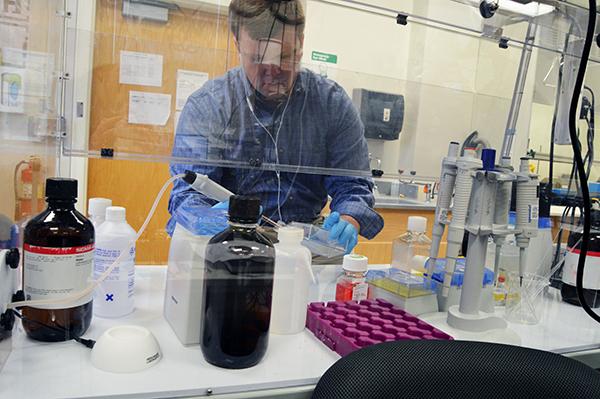
If Lawrence Bennett had an AC susceptometer in his lab, he said he’d be able to study the applications of magnetic properties like submarine mine detection, and even test experimental cancer treatments.
Bennett, a research professor of electrical engineering, said the $400,000 machine could help him and other researchers study magnetic storage or waste water treatment. To secure the six-figure machine, Bennett has placed it on a growing list of materials faculty hope to have donated to fill the Science and Engineering Hall.
The machines that make it onto researchers’ growing wish lists will have some of the greatest impacts on what happens inside GW’s $275 million Science and Engineering Hall. Fundraisers will pitch that lab equipment to donors, and whatever is funded will end up steering research focuses.
“The research we do is very dependent on the results we get from that,” he said. “We don’t do the research as well as we should because we don’t have the machine.”
Professors are preparing to move into the Science and Engineering Hall this winter. Wish lists give fundraisers specific items to point to and show potential donors how certain tools would move forward faculty work.
Can Korman, associate dean of research and graduate studies in the School of Engineering and Applied Science, said he has worked with faculty to create and update lists of resources that would improve their research abilities.
Korman said he tries to show potential donors how certain materials will advance the school’s research overall.
“I explain the science and the academic aspects of what is possible and what type of research will be conducted. I also explain how the SEH will function and the key role the core facilities will play in this multi-department and multi-school enterprise,” he said.
As part of GW’s $1 billion fundraising campaign, the University is aiming to bring in a combined $100 million to pay for the hall’s construction costs, the machines that will fill its labs and the professorships to be housed in the building.
Biology professor Robert Donaldson said his colleagues in chemistry and his own department are hoping to bring in a confocal microscopy machine, which would let them see inside living cells.
“I think that lots of professors are trying to identify equipment that would have a broad impact,” Donaldson said.
The quality and number of machines that fundraisers will be able to secure will also impact how likely professors are to secure grants to conduct cutting-edge research.
Donaldson pointed to institutions like the National Institutes of Health, which require researchers to demonstrate that their facilities are equipped to handle sensitive research before they sign a check.
“To get funding from institutes like the NIH, they need to see that the institution has the necessary scientific instrumentation to do the studies that are being proposed in the best way,” he said. “We need to be competitive with other people at other universities.”
Provost Steven Lerman said professors in the different departments have worked together to plan which materials to prioritize among all the departments that will be in the building.
“Obviously the amount of equipment you wish you had is vastly greater than the amount you can afford,” he said. “But we’ve already ordered some of the equipment, we’ve gotten some donations, and we’re looking for others.”
Professors can also form partnerships with manufacturers that might donate or give discounted rates on equipment, like professors in the forensic science department have done, he added.
Forensic science faculty members are looking to bring in donations to support research equipment that the building can support, including an imaging core and a nanofabrication core.
Researchers have already brought in electron microscopes and some nanotechnology, Lerman said.
William Briscoe, the chair of the physics department, said professors across departments are looking for oscilloscopes, vacuum pumps, signal generators and other high-quality power supplies.
When the University renovates lab space in Corcoran and Bell halls after departments move into the Science and Engineering Hall, Briscoe said researchers will also want new equipment for those spaces. He said science faculty in the Columbian College of Arts and Sciences are starting to make lists for how they plan to outfit those areas.
“Having a list can help the fundraiser look for specific items instead of generalizations. Most fundraisers would have no idea of our specialized needs,” he said.
Faculty are partnering with researchers on the Virginia Science and Technology Campus to see how they can best spread out research tools. Lerman said he could see science and engineering professors looking to focus on an area for genomics research in the new building as well.
Keith Crandall, director of the Computational Biology Institute, said wish lists help the development office have go-to options to pitch to donors that will most benefit researchers.
He said he hopes to bring in DNA sequencing equipment, which several departments would be able to use.
“Having these wish lists allows donors to target donations across a diversity of interests and to make sure that those targets are things that will actually help faculty be more productive at the University,” he said.







